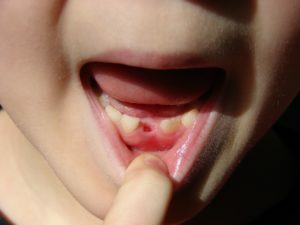 All parents are eagerly waiting for the first teeth of their children to fall out. Often this event is turned into a small holiday, as the child receives a gift from the "fairy" or "mouse".
All parents are eagerly waiting for the first teeth of their children to fall out. Often this event is turned into a small holiday, as the child receives a gift from the "fairy" or "mouse".
Children, prepared for the change of milk teeth, expect this with no less curiosity. There is a certain sequence of loss of milk teeth and the timing of their replacement by indigenous teeth. To last longer stay healthy it is important to adhere to the proper hygiene and teach the child to take care of the oral cavity.
The correct order of tooth loss
The change of milk teeth begins at about six years and lasts up to twelve. As a rule, by the age of fourteen the child should have a full arsenal of 28 permanent teeth. Milk teeth are only 20, all of which will be replaced by new, more robust. Below we will discuss in more detail what kind of milk teeth change and when this happens. For simplicity of understanding on the right, a visual table is presented.
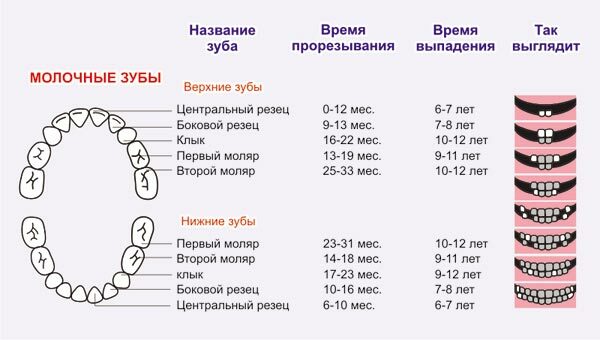
Scheme of loss of baby teeth
In the first six or seven years, the first teeth begin to stagger. As a rule, these are the central lower incisors. At seven-eight - the lateral incisors fall out. The age of 9-11 years is accompanied by loss of the first molars. Fangs begin to change on average 10-12 years. At the same time, the child must lose the second molars.
It should be noted that the lower canines and molars change earlier than the upper ones. As the upper canines grow one of the last, when the jaw line is practically formed, they often lack space, they grow unevenly, others move, they come down from above. It is because of the fangs that most orthodontic problems arise.
 The initial stage of the change of teeth can be accompanied by an increase in temperature, but in most cases it passes painlessly and without the participation of a dentist. Many parents and children are eagerly waiting for new teeth and start to get scared if the root does not get out right after dairy.
The initial stage of the change of teeth can be accompanied by an increase in temperature, but in most cases it passes painlessly and without the participation of a dentist. Many parents and children are eagerly waiting for new teeth and start to get scared if the root does not get out right after dairy.
Incisors can be absent for up to a year, the rest - up to one and a half to two years. This is a normal condition that does not require concern. If these terms are exceeded, it is recommended to consult a dentist. He will take a picture and find out the reason, which can consist in a lack of space in the series.
Oral care during the period of the change of milk teeth
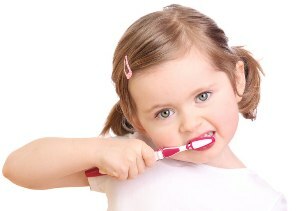 Huge hygiene of the oral cavity is of great importance when changing dairy teeth. New teeth are not as strong as in adults, since they have not yet fully formed a protective layer. It is for this reason that it is important to brush your teeth twice a day. Children prefer to avoid hygienic procedures, so at first it is necessary to help them, to teach them to use a brush, a shovel for the tongue. The use of dental floss and rinse liquids is welcome.
Huge hygiene of the oral cavity is of great importance when changing dairy teeth. New teeth are not as strong as in adults, since they have not yet fully formed a protective layer. It is for this reason that it is important to brush your teeth twice a day. Children prefer to avoid hygienic procedures, so at first it is necessary to help them, to teach them to use a brush, a shovel for the tongue. The use of dental floss and rinse liquids is welcome.
Another necessary measure before the approaching tooth change is complete sanitation of the oral cavity. Caries, localized in the milk teeth, can get into the newly growing ones. As already noted, young molars have a weak enamel, so they are prone to carious lesions.
 In most cases, the process of tooth loss is painless, as the root gradually dissolves, the tooth loses stability and falls out. Since the gums during this period still loose strong pain during eruption is not observed. But in rare cases a child can complain about it.
In most cases, the process of tooth loss is painless, as the root gradually dissolves, the tooth loses stability and falls out. Since the gums during this period still loose strong pain during eruption is not observed. But in rare cases a child can complain about it.
It is necessary to monitor the eruption process and conduct antiseptic procedures. To anesthetize the gum and normalize the microflora, use the same gels as when cutting the first teeth, for example, Kamistad-gel or Calgel .
Another important circumstance is the tracking of the correct formation of teeth in a row. At the slightest sign of displacement of permanent teeth, it is necessary to consult an orthodontist. While teeth grow, you can externally influence the beauty of a future smile.
 Since the enamel of permanent teeth is not sufficiently mineralized at first, you can contact the dentist. He will conduct appropriate procedures and strengthen the protective layer. In addition to this, with a change of teeth, the child must eat properly, placing emphasis on the following product groups:
Since the enamel of permanent teeth is not sufficiently mineralized at first, you can contact the dentist. He will conduct appropriate procedures and strengthen the protective layer. In addition to this, with a change of teeth, the child must eat properly, placing emphasis on the following product groups:
- dairy products, rich in calcium;
- fresh herbs, vegetables and fruits;
- fish.
The change of milk teeth by permanent is not just an expected process, it is an important period in which the protective property of enamel is formed. On how much nutrition a child has, whether oral hygiene is right, it depends on what teeth will be in the future and whether there will be a tendency to numerous dental problems.
Frequently Asked Questions
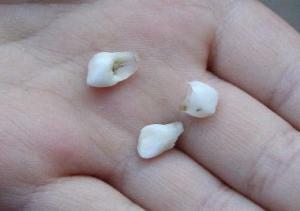 Parents often have controversial questions about changing their baby teeth. Often this is caused by the presence of sick teeth, which you want more quickly to replace strong healthy. In this connection, it is possible to concisely summarize important information concerning dairy and molar teeth.
Parents often have controversial questions about changing their baby teeth. Often this is caused by the presence of sick teeth, which you want more quickly to replace strong healthy. In this connection, it is possible to concisely summarize important information concerning dairy and molar teeth.
Do all milk teeth change to aboriginal( permanent) teeth?
Yes, that's it. The process of changing teeth is quite long, but all the teeth of the teeth will be replaced by permanent teeth. In addition to them, at least four more molars will be added. The entire process of dental growth should be completed by the age of 12-14 years. The remaining four wisdom teeth can grow throughout life or not grow at all.
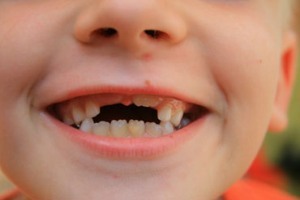
The photo shows the change of teeth in a child
How many baby teeth do children have?
Children have 20 milk teeth: eight incisors, four canines and eight molars. They differ significantly from permanent ones, since they are less bumpy. In addition, the milk teeth have broader roots, since they are a protective block for the forming constants.
Which teeth fall first?
The central incisors are the first to drop out, and they can fall out from above as well as from below, the lower ones usually begin to fall out. Then - lateral incisors, fangs and molars. The latter after the shift are called premolars. In general, the pattern of tooth loss and growth is about the same as in the eruption of dairy.
About how the teeth change in children tell the doctor an orthodontist in this video.
